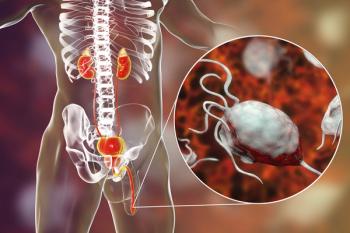
Oncology NEWS International
- Oncology NEWS International Vol 6 No 3
- Volume 6
- Issue 3
MRI Used to Detect Local Prostate Cancer Recurrence After Prostatectomy
CHICAGO--Because of its high cost and lack of universal availability, magnetic resonance imaging (MRI) has not been a prominent tool in the initial evaluation of prostate cancer. However, MRI is proving to be a highly accurate method of identifying local recurrence of prostate cancer after radical prostatec-tomy, Jeffrey M. Silverman, MD, said at the Radiological Society of North America (RSNA) annual meeting.
CHICAGO--Because of its high cost and lack of universal availability,magnetic resonance imaging (MRI) has not been a prominent tool in the initialevaluation of prostate cancer. However, MRI is proving to be a highly accuratemethod of identifying local recurrence of prostate cancer after radicalprostatec-tomy, Jeffrey M. Silverman, MD, said at the Radiological Societyof North America (RSNA) annual meeting.
Using endorectal surface coil MR imaging, Dr. Silverman and his colleaguesat Cedars-Sinai Medical Center, Los Angeles, prospectively analyzed 41men who had undergone radical prostatectomy an average of 26 months previously.
Thirty-five men had clinical suspicion of recurrent prostate cancerbecause of an elevated PSA level or the presence of a nodule or indurationon digital rectal examination. Six men served as controls because theyhad no signs of recurrence.
The men had four MRI sequences--a sagittal series of fat-saturated T2-weightedfast spin echo images, fat-saturated axial T2-weighted fast spin echo images,fat-saturated axial T1-weighted images, and fat-saturated axial T1-weightedimages after gadolinium enhancement.
All 31 men who were suspected of having recurrent cancer because ofhigher than usual PSA levels exhibited a prostate bed soft tissue noduleon MRI. The nodules were isointense compared to skeletal muscle on T1-weightedimages, hyperintense on T2-weighted images, and all were obviously enhancedafter gadolinium administration, he said.
Four men with a palpable nodule or induration detected at digital rectalexamination but stable PSA levels had fibrosis, and, in every case, MRimaging revealed no abnormality. The six men who had no clinical evidenceof recurrent prostate cancer also had unremarkable MR scans.
The sensitivity and specificity of endorectal surface coil MRI detectionof local recurrence was 100% in the study. Dr. Silverman concluded, therefore,that "endorectal surface coil MR imaging is a useful tool for menwho have undergone radical prostatectomy and are suspected of having localrecurrence of disease."
Articles in this issue
almost 29 years ago
Bills Address Women's Health and Cancer Issuesalmost 29 years ago
Possible Evolutionary Advantage Seen in Breast Cancer Genesalmost 29 years ago
Physicians Urged to Listen to Tamoxifen Users' Concernsalmost 29 years ago
Neck Check Exam Aims at Early Detectionalmost 29 years ago
NCAB to Consider Mammography in Fortiesalmost 29 years ago
Endocrinologists Issue Clinical Guidelines for Thyroid Canceralmost 29 years ago
Fatigue May Be Most Under-recognized, Undertreated Cancer-related Symptomalmost 29 years ago
Hormone Replacement Therapy: Making Informed DecisionsNewsletter
Stay up to date on recent advances in the multidisciplinary approach to cancer.


















































































